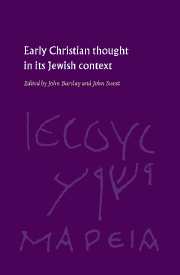Book contents
- Frontmatter
- Contents
- List of contributors
- Preface
- List of works by Morna D. Hooker
- List of abbreviations
- Chapter 1 Introductory Essay
- I THE SOCIAL CONTEXT OF EARLY CHRISTIANITY
- II SOME EARLY CHRISTIAN SOURCES
- Chapter 4 Jesus
- Chapter 5 Matthew
- Chapter 6 Mark
- Chapter 7 Luke–Acts
- Chapter 8 John
- Chapter 9 Paul
- Chapter 10 Deutero-Pauline letters
- Chapter 11 Hebrews
- Chapter 12 Revelation
- Chapter 13 Other early Christian writings: ‘Didache’, Ignatius, ‘Barnabas’, Justin Martyr
- III SOME EARLY CHRISTIAN THEMES
- Index of names
- Index of subjects
- Index of texts
Chapter 11 - Hebrews
from II - SOME EARLY CHRISTIAN SOURCES
Published online by Cambridge University Press: 22 September 2009
- Frontmatter
- Contents
- List of contributors
- Preface
- List of works by Morna D. Hooker
- List of abbreviations
- Chapter 1 Introductory Essay
- I THE SOCIAL CONTEXT OF EARLY CHRISTIANITY
- II SOME EARLY CHRISTIAN SOURCES
- Chapter 4 Jesus
- Chapter 5 Matthew
- Chapter 6 Mark
- Chapter 7 Luke–Acts
- Chapter 8 John
- Chapter 9 Paul
- Chapter 10 Deutero-Pauline letters
- Chapter 11 Hebrews
- Chapter 12 Revelation
- Chapter 13 Other early Christian writings: ‘Didache’, Ignatius, ‘Barnabas’, Justin Martyr
- III SOME EARLY CHRISTIAN THEMES
- Index of names
- Index of subjects
- Index of texts
Summary
The church's understanding of itself in relation to the Judaism from which it emerged has tended to take one of two routes: either it has gone the way of Marcion and denied its Jewish matrix; or it has affirmed it in such a way as to Judaize Christianity. Nowhere is this more evident than in the interpretation of the Letter to the Hebrews. On the one hand, it has been presented as a polemic against the claims of first-century Judaism; as designed to uphold a Christian message which is radically discontinuous from that of its Jewish parent body. On the other, it has been seen as a presentation of the Christian faith wholly within a Jewish framework; as nothing but true, fulfilled Judaism. The fact that Hebrews can be read from such divergent perspectives should alert us to the need to tread warily between the Scylla and Charybdis of understanding the author's viewpoint and the situation of the community to which he wrote as simply either continuous or discontinuous with Judaism.
Any adequate judgement of Hebrews must take seriously both its continuities and discontinuities with first-century Judaism, bearing in mind the notorious and well-rehearsed difficulties of ‘placing’ Hebrews within a wide spectrum of possible first-century contexts.
- Type
- Chapter
- Information
- Early Christian Thought in its Jewish Context , pp. 145 - 159Publisher: Cambridge University PressPrint publication year: 1996



